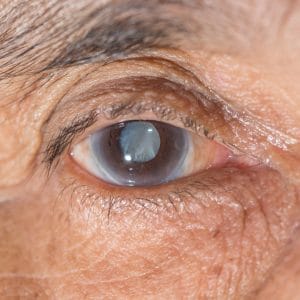Medically Reviewed by: Mark L. Mayo, M.D.
The Top 3 Early Signs of Cataracts — With Photos
Just because cataracts can be a natural part of the aging process doesn’t mean you shouldn’t remain on the lookout for the early signs of cataracts. Discover the top three early signs of cataracts, including what those signs may look like (cataract pictures provided) and how to address those signs.
For more information on the early signs of cataracts (including fast-growing cataracts), take a look at our previous articles.
What are the first signs of cataracts?
1. General changes in vision quality
The early sign of cataracts that brings in the most patients are general concerns about changes in vision quality: the inability to see distant objects clearly, sensitivity to light, double vision, and halos around lights at nighttime. These changes are rarely drastic, and many patients assume that they simply need a change in prescription.
2. Blurred / cloudy vision
The first sign of cataracts will vary from person to person, but the next sign is usually blurriness. Blurred vision from cataracts occurs due to the buildup and clumping of proteins in your eye’s lens, which will block light from reaching your retina.
At first, only part of your vision may be blurred, but this area will likely grow over time if your cataract(s) remain untreated.
3. Eye discoloration
Eye discoloration is easily the most visible early sign of cataracts. The buildup of proteins may cause your lens to begin to yellow or brown. Unlike the other early signs of cataracts, however, your family and friends may be able to spot lens discoloration. It’s not uncommon for us to meet patients who have come to visit us due to the urging of individuals close to them.
This image shows what a cataract looks like in an advanced stage.
Catching and treating cataracts
Not all eye doctors are advocates for early cataract surgery. Depending on the types of cataract a patient is facing and the severity of vision loss they’re contending with, your doctor may opt to wait for a later date.
At the same time, many patients feel that the earlier you treat cataracts, the fewer sights you’ll miss out on. Ultimately, whether or not to pursue cataract surgery is a decision that should be made between you and your doctor.
In the meantime, we highly recommend learning how to avoid cataracts naturally and reading up on cataracts and sun exposure.
Laser eye surgery for cataracts and Eye Center of Texas
Eye Center of Texas provides the latest in blade-free cataract treatment: laser eye surgery for cataracts. Our nationally-recognized surgeons have performed over 80,000 successful laser cataract surgeries and are recommended by over 300 referring doctors.
Miss less of life’s special moments. Call us at 713-797-1010 or request an appointment online today to get started on your journey to better vision.
Related Resources
Related Articles
Financing Options Available
Apply today to find a financing option that meets your needs.
Our Locations
Houston/Bellaire
6565 W. Loop S., Suite 650Bellaire, TX 77401
Medical Office:
713-797-1010
Medical Fax:
713-357-7276
LASIK/Near Vision:
Office: 713-395-1515
Fax: 713-357-7278
Pasadena
4415 Crenshaw RoadPasadena, TX 77504
Medical Office:
281-977-8800
Medical Fax:
281-977-8877
Sugar Land
15200 S.W. Freeway, Suite 130Sugar Land, TX 77478
Medical Office:
281-277-1010
Medical Fax:
281-277-4504
Clear Lake
455 E. Medical Center Blvd., Suite 110Webster, TX 77598
Medical Office:
281-332-1397
Medical Fax:
281-282-9152
Katy
Greenhouse Medical Plaza2051 Greenhouse Road, Suite 110
Houston, TX 77084
Medical Office:
346-547-7070
Medical Fax:
281-214-2971
The Woodlands/Conroe
100 Medical Center Blvd., Suite 118Conroe, TX 77304
Medical Office:
936-647-1610
Medical Fax:
936-647-1620





